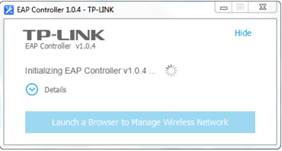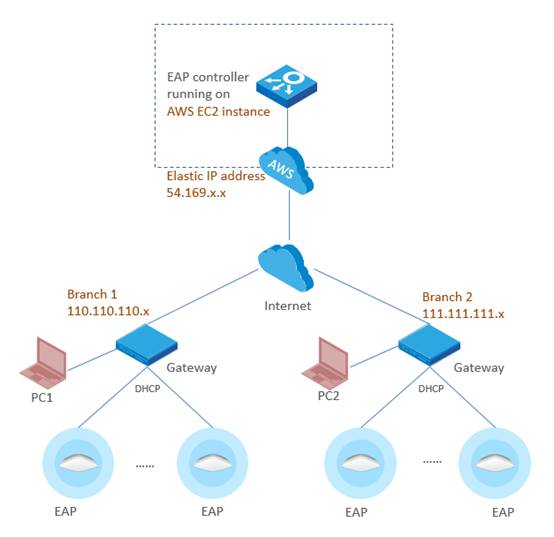How to deploy EAP controller on a private cloud (AWS EC2)
Overview
EAP controller (2.0.3 and newer non-cloud versions) supports L3 management. An EAP controller can manage EAPs of multiple remote networks crossing internet. However, it will require to set up port-forwarding or VPN tunnels if there are NAT firewalls in front of EAP controller. (See FAQ913)


Some users may want to install the EAP controller on a private cloud platform, so as to achieve L3 management from anywhere without hosting a LAN PC. Moreover, if the cloud server comes with public IP addresses, it can also save the work of setting up port-forwarding or VPN tunnels for penetrating through NAT firewalls.
A Workaround
Although EAP controller is a non-cloud-application, it can still be installed on a cloud-based Windows host, which can be a workaround to achieve part of the demand.
In this article, readers will learn how to install and run an EAP controller on an AWS EC2 Windows host.


Note: TP-LINK will develop a true cloud-based EAP controller service in the future, so the workaround going to be introduced in this article is only an interim solution before the final release of the true cloud-based controller service.
About AWS EC2
Amazon Elastic Compute Cloud (Amazon EC2) provides scalable computing capacity in the Amazon Web Services (AWS) cloud. One significant feature of EC2 is virtual computing environments, known as instances, which includes Windows virtual hosts.
The Amazon Web Services (AWS) Free Tier provides new registered users with 750 hours per month of Windows t2.micro instance usage for free within certain usage limits. You are now strongly recommended to refer to the page of AWS Free Tier for detailed information. All information given herein are subject to changes or update by AWS without prior notice.
Here we take AWS EC2 as an example to introduce how to install and run an EAP controller on a private cloud.
Part 1: Get AWS EC2 Ready
1.1 Create an AWS account
Note: Skip this step 1 and login directly if you have already an AWS account.
- Open http://aws.amazon.com/, and then choose Create an AWS Account.
- Follow the online instructions to create an AWS account.
About Region
Amazon has data centers in different areas of the world (for example, North America, Europe, and Asia). Correspondingly, Amazon EC2 is available to use in different regions. By launching instances in separate regions, you can design your application to be closer to specific customers or to meet legal or other requirements.
You can choose a preferred region before creating a Windows instance.


1.2 Launch a Windows instance
Note: Skip this step 2 if you have already a Windows instance available for running an EAP controller.
- Open the Amazon EC2 console at https://console.aws.amazon.com/ec2/.
From the console dashboard, choose Launch Instance.


- The Choose an Amazon Machine Image (AMI) page displays a list of basic configurations, called Amazon Machine Images (AMIs), which serve as templates for your instance. Select the AMI for Microsoft Windows Server. Notice that in this tutorial we choose Windows Server 2012 R2 marked "Free tier eligible" as an example.


- On the Choose an Instance Type page, you can select the hardware configuration of your instance. Select the t2.micro type, which is selected by default. Notice that this instance type is eligible for the free tier.


- Choose Review and Launch to let the wizard complete the other configuration settings for you.
- On the Review Instance Launch page, under Security Groups, you'll see that the wizard created and selected a security group for you. Now choose Edit security groups.
Security Group Settings (Important)
A security group is a set of firewall rules that control the traffic for your instance. To achieve the goal of managing remote EAPs, add rules that allow unrestricted access to the following ports.
- TCP PORT 8088
- TCP PORT 8043
- UDP PORT 29810
- TCP PORT 29811
- TCP PORT 29812
- TCP PORT 29813
Also allow RDP access for Windows Remote Desktop access.


- Then choose Review and Launch.
- On the Review Instance Launch page, choose Launch.
- When prompted for a key pair, select the key pair that you created if you have one. Otherwise, you can create a new key pair. Select Create a new key pair, enter a name for the key pair, and then choose Download Key Pair. This is the only chance for you to save the private key file, so be sure to download it. Save the private key file in a safe place. You'll need to provide the name of your key pair when you launch an instance and the corresponding private key each time you connect to the instance.
Note: Don't select the Proceed without a key pair option. If you launch your instance without a key pair, then you can't connect to it.
- When you are ready, select the acknowledgement check box, and then choose Launch Instances.
- A confirmation page lets you know that your instance is launching. Choose View Instances at the bottom of the page to close the confirmation page and return to the EC2 console.


- Back to EC2 console à Instances menu, you can see that the newly launched Windows instance is now running.


1.3 Assign an Elastic IP address for the Windows host
Although it shows that the instance is assigned a public IP address now, but this default IP address is not permanent. Once you shut down or reboot the instance, it can be released or changed to another one.
To have static public IP address for the Windows, we need to create an Elastic IP address and assign it to the instance. An Elastic IP address is a static public IP address that you can allocate to your account. You can associate it to and from instances as you require, and it's allocated to your account until you choose to release it.
In the EC2 console, navigate to NETWORK & SECURITY -> Elastic IPs, the list should be empty if you haven’t create any. Now click Allocate New Address, confirm to allocate when prompted.
Then a new Elastic IP address entry will be shown in the list.
Select the entry, click Actions -> Associate Address.


Click the Instance input box and choose the Windows instance in the drop-down list. Click Associate to associate this Elastic IP address to the Windows instance.


Go back to Instances menu, now you can see the Windows instance is now associated with the Elastic IP address.


With all the above steps, the AWS EC2 Windows host is now ready.
Part 2: Install EAP controller on EC2
2.1 Connect to Windows through Remote Desktop
In EC2 console, select the Windows instance and click Connect.


You can connect to your Windows instance using a remote desktop client of your choice, and by downloading and running the RDP shortcut file as the prompted instruction says.
Before actually connect through RDP, you must Get Password using your Key file which is saved in previous steps. Upload the Key file and then choose Decrypt Password to get your password.


With the provided username/password now you can connect to the Windows instance through remote desktop (RDP) client from any remote PC at anywhere you like.




2.2 Download and Install EAP controller on EC2
Note: When the IE ESC is enabled, you get pop-up all the time and you are asked to add every new URL to the IE trusted sites zone. You may want to disable IE ESC temporarily for the convenience of downloading the EAP controller from TP-LINK official websites.
To disable IE enhanced security in windows server 2012 R2, launch the Server Manager, on the left hand side click on Local Server. On the right hand side click on the On link next to IE Enhanced Security Configuration.


In the prompted windows, click on Off to turn off the IE ESC.
Then visit www.tp-link.com, search any model of the EAP series, e.g. EAP220. In the product page, navigate to Support page and download the latest EAP controller under Utility tab.
After download, extra the zip and install the EAP controller through the setup wizard.




After installation, launch EAP controller.exe and finish the Quick Setup Wizard. Note down the username/password and then keep the EAP controller running.


Now, everything of the EC2 instance is ready. You can now leave the EC2 running since its settings are all finished.
You can access the controller’s web UI from a remote PC through the URL Https://Elastic IP:8088
The next steps are performed at the EAP sides.
Part 3: Settings at EAP side
Still take the following topology as an example.


First of all, the EAPs must have internet access, which means you should assign them correct IP/gateway parameters through DHCP (recommended) or manual configuration. The EAPs default to DHCP so this shouldn’t be a problem as long as there is proper DHCP service in LAN.
Then comes the most important part. At EAP sides the controller’s public IP address, in the above example 54.169.x.x need to be configured into each EAP device, so that the EAPs can know where to find the EAP controller through internet. There are two methods to configure the controller’s IP address into the EAPs.
Method 1. Via EAP Discover Utility
- Download EAP controller from TP-LINK website. Install EAP controller on a PC at site Branch 1. The PC should be in the same IP subnet as EAPs. In the example it is PC1.
- Run EAP Discover Utility (You will find it at C:\Program Files (x86)\TP-LINK\EAP Controller\bin if you haven’t changed the installation path). All the EAP devices in the local network will be listed.


- Since all the EAPs have the same Username and Password, you may use Batch Setting to set controller IP for them all. If your EAP devices have different username and password you can use the manage button to set the controller hostname/IP respectively.


- Wait until the status show as Setting Succeed.


- A while later the EAPs will be displayed as pending APs on controller waiting for adoption and management. You can adopt them using the EAP’s username/password. (Default: admin/admin)


- For EAPs located in Branch 2 use the same methods to set the controller’s IP address.
Method 2. Set option 138 on DHCP server
EAP devices can request controller IP via option 138 through DHCP.
Take Branch 1 as example.
- Suppose the DHCP server in Branch 1 is capable of configure variable DHCP options. Set the controller IP as the option 138 value on it.
- All the EAPs in the local network will be aware of the controller’s IP address automatically through DHCP communication right after boot up.
How to set option 138 on DHCP server varies from implementation to implementation which is out of the scope of this document. Please refer to DHCP server documentation for help. The below two examples used in our test are for your reference.
Cisco IOS CLI:
ip dhcp pool test
network 192.168.1.0 255.255.255.0
default-router 192.168.1.1
dns-server 8.8.8.8
option 138 ip 56.169.x.x
For more details please refer to Cisco website.
MikroTik RouterOS CLI:
#Assume you have already setup a dhcp server with item number 0
#0xC0000002 equeals 56.169.x.x
/ip dhcp-server option add code=138 name=controller value=0xC0000002
/ip dhcp-server network set 0 dhcp-option=controller
For more details please refer to MikroTik manual.
This article applies to EAP controller 2.0.3 and later non-cloud-based controller.
Is this faq useful?
Your feedback helps improve this site.
TP-Link Community
Still need help? Search for answers, ask questions, and get help from TP-Link experts and other users around the world.









_EU_3.0_2401__normal_20240119043538b.png)
4.0-F_normal_20221110005015k.png)